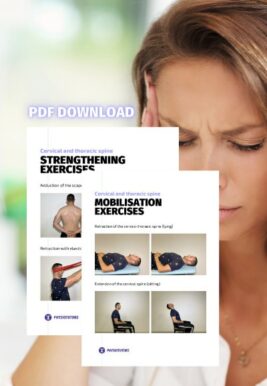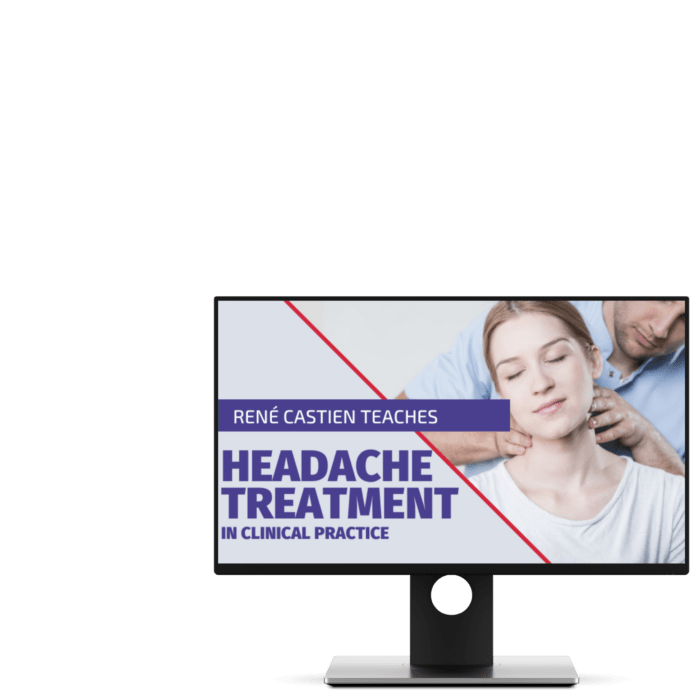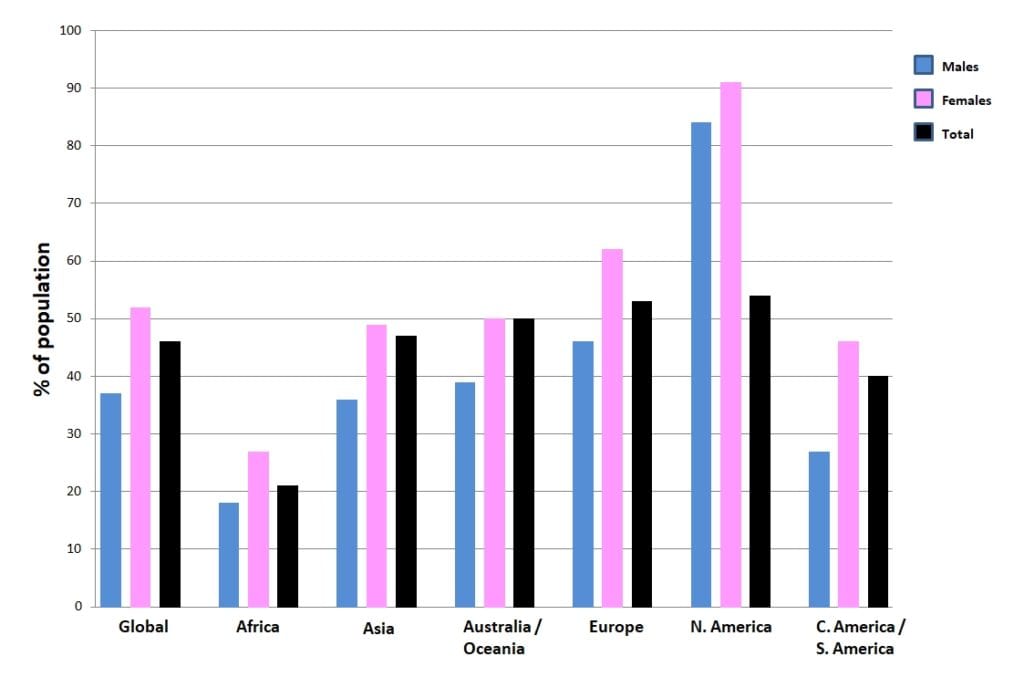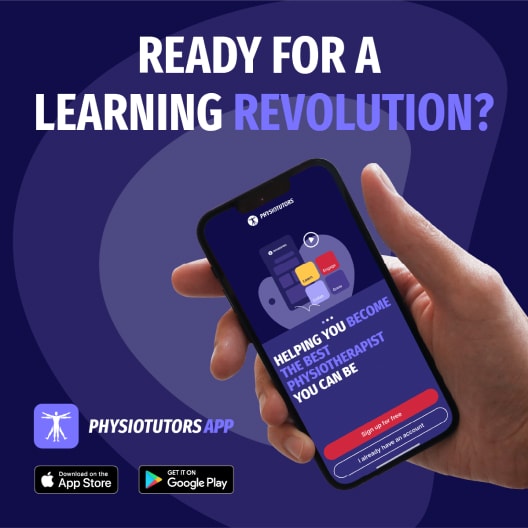Tension-Type Headaches | Diagnosis & Treatment for Physios

Tension-Type Headaches | Diagnosis & Treatment for Physios
Introduction & Epidemiology
Headaches can manifest on their own but are also a very common symptom in neck pain patients as more than 60% of patients with a primary neck pain complaint report having concordant episodes of headaches. Therefore it’s essential to find out what kind of headache the patient is suffering from.
To start off let’s differentiate between primary and secondary types of headaches. But what does this mean? Simply put, primary headaches are a “disease themselves” whereas, in secondary headaches, the headache is a symptom of another condition. So primary headaches would be migraines, tension-type headaches & cluster headaches. Secondary type headaches are headaches caused by tumors, hemorrhage, other trauma, TMJ dysfunction, substance overdose, or neck pain aka. The cervicogenic headache.
Now let’s take a closer look at tension-type headaches, which are primary types of headaches.
Epidemiology
When looking at the current prevalence of different forms of headaches, TTH is the most prevalent form in the adult population worldwide with a mean prevalence of 42%, followed by migraine with 11% (Stovner et al. (2007). The following graph shows the current prevalence of different forms of headaches in different age categories (Stovner et al. (2007):

The following figure shows the prevalence of headaches on different continents around the world:
Follow a course
- Learn from wherever, whenever, and at your own pace
- Interactive online courses from an award-winning team
- CEU/CPD accreditation in the Netherlands, Belgium, US & UK
Clinical Picture & Examination
Tension-type headaches can vary from infrequent episodic, frequent episodic, to chronic. As seen in this table.

While the frequency and duration differ, patients in all three categories need to report at least 2 of the following four characteristics (ICD-H-III):
-
- The headache is bilateral
- It has a pressing or tightening quality but NOT pulsating
- The intensity is mild to moderate so a patient will usually still be able to complete ADLs as
- The headache is not aggravated by routine physical activity such as walking or climbing stairs.
Also, there is
- NO nausea or vomiting
- No more than one of photophobia or phonophobia which is sensitivity to light and sounds respectively
Tools you can use to assess the impact of a headache on your patient are the HIT-6 questionnaire. Also note that it can be difficult for a patient to answer all of the questions on duration, intensity, and characteristics of their headache during your assessment. Therefore asking them to complete a headache diary can help in the assessment and management of the headache and you should be aware that there can be overlap between multiple headache disorders.
Examination
In comparison with healthy controls, the average patient with tension-type headaches differs on provocation, cervical range of motion, neck muscle endurance and forward head position.
The goal of provocation tests is to recreate the patient’s familiar pain. This way, you are able to confirm the location of nociception in the cervical structures, possibly leading to referred pain to the head. While provocative testing for CGH can be done with the techniques shown in the following tab, the phenomenon of referred pain to the head for tension-type headaches and migraine can be provoked with the Watson test:
Although no clear cut-off values are given, the performance time can give an indication of neck flexor endurance:
Upper cervical range of motion in the direction of rotation can be reliably and accurately assessed with the Flexion-Rotation Test (Hall et al. 2010a, Ogince et al. 2007, Hall et al 2010b). This test – if positive – can give you an indication of limited rotation on segments C1/C2. In turn, hypomobility on C0/C1 or C2/C3 can lead to this limitation in rotation on C1/C2.So in case of a positive test, we still need to perform intervertebral motion assessment of all upper cervical segments in order to find the dysfunctional segment.
Forward head posture (FHP) refers to the anterior positioning of the head relative to the torso in a reproducible upright posture. Measuring the horizontal gap between the tragus and the C7 spinous process has been reported to be the most reliable method compared to the horizontal gap between the tragus and acromion process and the craniovertebral angle between the tragus and the C7 spinous process (Lee et al. 2017). The authors report almost perfect intra-rater reliability in both sitting (comfortably or straight) and standing (comfortably or straight) positions with ICC values >0.9 in young healthy Chinese individuals.

When looking at norm values the literature is rather scarce and usually, the craniovertebral angle is described as the sole measurement. Nemmers et al. (2005) describe that a clinician could expect young healthy adults to exhibit an average normal FHP within a 10° range from 49° to 59° when the craniovertebral angle was used as a reference. In their study, the authors report an angle of 48.84° for the 65-74-year-old, 41.2° for the 75-84-year-old, and 35.6° for people in the 85+ range in healthy community-dwelling older women.
In their randomized controlled trial, Harman et al. (2005) defined a forward head posture as soon as the distance between the tragus to the posterior angle of the acromion was greater than 5cm. Fernández-de-las-Peñas (et al. 2006) found a craniovertebral angle of 45.3° in patients with chronic TTH compared to an angle of 54.1° in healthy controls.
Caneiro et al. (2010) showed that slumped sitting is associated with an increased cervical flexion and anterior translation of the head compared to upright sitting. Such postural stress might activate peripheral cervical nociceptors in upper cervical structures like the suboccipital muscles or facet joints which can lead to referred head pain (Mingels et al. 2019). Neuroanatomical, biomechanical, and non-nociceptive pathways seem to justify profiling patients based on a postural trigger. Further research is needed to determine the contribution of postural dysfunctions to headaches and the effect of specific interventions (Mingels et al. 2019).
100% Free Headache Home Exercise Program

Follow a course
- Learn from wherever, whenever, and at your own pace
- Interactive online courses from an award-winning team
- CEU/CPD accreditation in the Netherlands, Belgium, US & UK
Treatment
Van Ettekoven et al. (2006) compared a craniocervical flexion training(CCFT) program with physiotherapy to physiotherapy alone in patients with chronic tension-type headaches. They found a decrease in headache frequency, duration, and intensity in the CCFT group at 6-week follow-up compared to the physiotherapy group. At 6 months follow-up, even after the intervention program had stopped, the effect regarding decreased headache frequency still remained significant.
Castien et al. (2011) have compared manual therapy (MT) interventions including spinal mobilization / manipulation of the cervical and thoracic spine, posture correction, and craniocervical exercises with usual care by a general practitioner in a group of patients with chronic TTH. They found a significantly larger reduction of headache frequency, disability, and increased cervical function in the MT group at 8 weeks follow-up Disability and cervical function While the difference in the primary outcome headache frequency was still significant at 26 weeks, disability and cervical function were not.
2 years later the authors examined which part of their MT intervention was effective (Castien et al. 2013). They found that increased neck flexor endurance appeared to be the working mechanism behind the MT intervention. An increase in cervical ROM and improved posture did not mediate the effect of decreased headache symptoms.
The same authors went on to examine if there is a relation between isometric neck flexor strength and the decrease of pressure-pain thresholds – an indicator for peripheral and central sensitization in patients with chronic TTH (Castien et al. 2015). Their results indicate that a decrease in PPT correlates with increases in isometric strength of neck flexors in patients with chronic TTH in the short- and long term.
In the case that neck endurance is reduced, you might want to try the following exercise program:
A small part of the intervention in the study of Castien et al. (2011) consisted of manual pressure techniques abbreviated as MTP, for which only anecdotal evidence is available as a treatment in isolation. In the following video we will show you 3 manual pressure techniques that can decrease pain and increase upper cervical range of motion.
MTP1:
Have your patient in prone position. If possible you can lower the head part of the bench so that the patient’s head is in slight flexion. This technique targets the ipsilateral rectus capitis posterior major. This muscle runs obliquely from the spinous process of C2 to the lateral part of the inferior nuchal line at the occiput.In order to reach the muscle, we will have to shift the trapezius muscle medially to reach underneath it. You can ask your patient to slightly lift his head to see the course of the trapezius. Inevitably, we will have to palpate through the splenius, which is only a thin muscle layer that still allows you to palpate through to the rectus capitis posterior major.
Now, apply pressure to this muscle with your thumb into medial and cranial direction toward its attachment. This will result in local and then referred pain to the head in patients with tension-type headaches. Hold the pressure for 20 to 60 seconds until the referred head pain has decreased, followed by a decrease in local pain until only local pressure remains. Afterwards, repeat the technique on the contralateral side as well.
MTP 2:
This technique combines compression of myofacial structures with a stretch of the rectus capitis posterior major.To conduct the technique have your patient in supine position and place your index or middle finger on the posterior tubercle of C1, which lies deep between the occiput and spinous process of C2. You can increase your pressure by putting another finger on top. Then gradually increase the tension in the contralateral rectus capitis posterior major by rotating the patients head towards you until submaximal pain is reported by the patient. This can again cause local and referred head pain in patients with tension-type headaches. You can fixate the rotation with your own belly or thigh, so it can be maintained in a submaximal position. Hold the pressure and the stretch 20 to 60 seconds until the referred head pain has decreased, followed by a decrease in local pain until only local pressure remains. Afterwards, repeat the technique on the contralateral side as well.
MTP3:
This technique is targeted at the upper cervical joints C1/C2 and C2/C3.To perform the technique for C1/C2 have your patient in supine lying position and support his head on your forearm. Then rotate the patient’s head 20 degrees away from you and place your thumb onto the ipsilateral arch of C1. Afterwards, rotate your patient’s head back until you feel the resistance on your thumb.Again, this technique will elicit local pain and referred pain to the head in patients with tension-type headaches. Hold the pressure and the stretch 20 to 60 seconds until the referred head pain has decreased, followed by a decrease in local pain until only local pressure remains.
In order to target C2/C3, rotate the patient’s head 30 degrees away from you. Then perform an upward slip movement at the ipsilateral facet joint of C2/C3 by exerting pressure on the ipsilateral arch of C2. Again, hold this position 20 to 60 seconds until first the referred head pain is diminished and the local pain has decreased as well until only local pressure remains.
Afterwards, repeat the technique on the contralateral side as well.
Unlike trigger point techniques, the manual pressure techniques are not targeted at painful taut bands in certain muscles.The goal is to elicit a nociceptive afferent stimulus to the upper cervical area that is innervated by the dorsal ramus of C2. This nociceptive stimulus has shown to activate supraspinal inhibiting systems like the periaqueductal gray (PAG) and the rostroventral medulla abbreviated as RVM. These structures can both inhibit nociception at the dorsal horn.Although pain is usually only decreased on short-term in approaches targeting the neurological system, anecdotal evidence shows that these techniques might have a long lasting effect.
Want to learn more about headaches? Then check out our following blogs & research reviews:
- Physical Tests for Headaches: Useful?
- The Efficacy of Aerobic Exercise vs. Strength Training in the Treatment of Migraine
- Podcast Episode 031: Headaches with René Castien
References
Follow a course
- Learn from wherever, whenever, and at your own pace
- Interactive online courses from an award-winning team
- CEU/CPD accreditation in the Netherlands, Belgium, US & UK
Finally Learn how to Diagnose & Treat Patients with Headaches


What customers have to say about this online course
- Ryanne Groenewegen - van Gulik22/04/25Ideale online cursus Voor online begrippen en hele sterke cursus. Wordt duidelijk vermeld wat “verplichte” stof is en verdiepende stof. De presentaties van René zijn een beetje statisch gepresenteerd maar benutten de meest essentiële informatie. De toetsen/quiz waren soms vrij moeilijk. Ga daar goed voor zitten.
Toevoeging voor mij zou nog zijn meer casus /case report voorbeelden in de toetsen verwerken en net zoals uitleg bij hcwk palpatie in elk filmpje toelichting en uitleg van handvattingen en richtingen. Al met al echt ideaal het in je eigen tijd te kunnen doen en er bovendien ook veel van te leren!Simon Fayers21/02/25The confusion of headache diagnose lifted Ive been working many years but always felt that my tool box was a little empty when dealing with headache patients. This course has given me both a theoretical and practical base to build upon in clinical practise. The course is quite heavy on research papers as they are looking to evidence everything that is taught and also perhaps as Rene is primarily a researcher and this is an important area of interest for him. There are plenty of practical videos on testing and treatment.
Really happy i took this course. - Raphael Acohen16/02/25Interessant, pittig en droog Als algemeen fysiotherapeut vond ik deze cursus inhoudelijk sterk en wetenschappelijk goed onderbouwd. De vele papers en analytische benadering gaven veel diepgang, maar maakten het ook best pittig. Daarnaast kwamen de filmpjes vrij droog over, wat het soms lastig maakte om de aandacht erbij te houden. Visuele praktijkvoorbeelden hadden de leerervaring nog levendiger gemaakt. Toch een waardevolle cursus voor wie echt de diepte in wilMenno Sormani31/12/24Headache treatment in clinical practice Wat fijn dat physiotutors de samenwerking is aangegaan met Rene Castien. Heel erg duidelijke cursus met zowel diagnostiek als behandeling bij hoofdpijn.
- Martijn Liebregts29/12/24Prima cursus Beste Physiotutors,
De online cursus "Behandeling van hoofdpijn in de klinische praktijk" is mijn eerste cursus welke ik bij jullie afgerond heb. Mijn verwachtingen waren niet al te hoog aangezien deze manier van scholing niet mijn voorkeur heeft. Maar ik moet zeggen dat ik positief verrast was. De cursus is prima te doorlopen, alles zit erg goed, duidelijk in elkaar en je kunt op een prettige manier studeren. Voor mij persoonlijk was het wel erg veel leesmateriaal. Dit is een goede en interessante manier van studeren als je je studietijd zelf wilt invullen.Hayko Oosterveld29/12/24Headache Treatment in Clinical Practice Weer een goede cursus van Physiotutors: Headache Treatment in Clinical Practice
Goede cursus, met veel (wetenschappelijke) achtergrond informatie en heel bruikbaar voor de praktijk. - Rob van Dam24/12/24Hoofdpijnbehandeling in de klinische praktijk Goede cursus, veel geleerd, wel even zoeken voor mij, aangezien dit de eerste x is dat ik een online cursus doe.
Fijn is dat je zelf kunt bepalen wanneer je de lessen volgt.
De opgegeven tijd die voor de cursus staat heb ik wel heel ruim overschreden.
De vertaling naar Nederlands viel me wel tegen, ik heb de cursus toch maar in het Engels gevolgd.
Ik ga in de toekomst zeker nog eens een cursus via physiotutors volgen.Rutger18/12/24Headache Treatment in Clinical Practice geweldige course. Veel informatie maar ook super goede behandeltechnieken. Echt een aanrader - Jelle Visser18/12/24Headache Treatment in Clinical Practice geweldig. heel veel informatieTodd A.07/12/24Thorough course with the necessary depth of material Appreciated the level of RCT evidence presented in the lectures.
- Ilse Lammers-Vredenberg03/12/24Veel geleerd maar ook geïrriteerd Mijn ervaring met deze cursus is wisselend. Laat ik voorop stellen dat ik enorm veel geleerd heb en nu helemaal up to date ben met de huidige standaard qua onderzoek en behandeling van hoofdpijn.
Wel kost de cursus heel veel meer tijd dan de 14 uur die er volgens Physiotutors voor staat. Ook zijn de artikelen niet beschikbaar in de cursus; dan moet je eerst een mailtje sturen en dan krijg je een link waar grotendeels de artikelen in staan. Voordat ik dus hier achter was had ik veel tijd aan het zoeken van de artikelen besteed.
Het is goed dat er getest wordt d.m.v. vragen maar deze zijn soms onduidelijk gesteld en hebben niet altijd betrekking op de stof. Ook was er een vraag over een artikel wat niet gelezen hoefde te worden. Kleine dingen die toch irriteren; want je moet uiteindelijk toch je toetsvragen goed hebben.
Het is dat ik een master MT gedaan heb want als algemeen FT was ik vastgelopen op alle wetenschap en bijbehorende onderzoeksmethodieken.maria Kramer28/11/24goede cursus voor hoofdpijn klachten Een iets wat te wetenschappelijke cursus over hoofdpijnklachten. Maar goed om je te verdiepen in de anatomie en mechanismes rond hoofdpijnklachten te leren. Tweede deel een aantal goede handvaten voor behandeling van deze klachten. - Marty26/11/24Goed overzicht van hoofdpijn Ik vond het een mooi overzicht van de verschillende soorten hoofdpijn met zeer uitgebreid
Aandacht voor de symptomen, verschillen en diagnostiek.
De filmpjes zijn heel duidelijk. Het gesproken Engels is goed te verstaan of anders is de ondertiteling voldoende.
Wat mij betreft moet je de Engelse taal wel voldoende begrijpen om de gehele cursus inclusief artikelen
Te voltooien. De toetsen zijn niet al tè moeilijk…😉
Een groot minpunt vind ik wel de gebrekkige werking van de website in z’n algemeen. Onoverzichtelijk en in begin lastig te doorgronden..
Groot voordeel is de gunstige prijs gemiddeld per accreditatie punt. 👍Wouter Linschoten26/11/24Interessant, overzichtelijk en fijne leerstof! De manier waarop deze cursus in elkaar is gezet is fantastisch. Het is ontzettend overzichtelijk en geeft een goed beeld van de structuur en vooruitgang in je cursus. Bovendien Zijn de video-lectures en vooral de uitleg oefeningen zoals we gewend zijn van Physiotutors: Ontzettend goed gemaakt en duidelijk. Alles is bovendien zeer uitgebreid en goed onderbouwd met uitgebreide literatuur. Ik ga zeker weer een cursus van ze doen. Keep up the good work! - Eric20/11/24Onmisbaar als behandelaar van hoofdpijn Wanneer je meer inzicht in de achtergrond van hoofdpijn wilt krijgen, behandelmethodens en technieken dan is deze cursus onmisbaarRichard Pamboer17/11/24Leerzame cursus Fijn om zelf te kunnen bepalen wanneer je wil studeren. Goede opzet van de cursus.
Grootste minpunt was de slechte vertaling in de ondertitels, verder prima! - Christine Petrides, Physiotherapist10/11/24Clear, structured teaching that improved my reasoning. I loved learning about different headache types and how to organize my clinical reasoning. The lecturer explained everything in a clear, structured way, and the downloadable resources will be useful for a long time. Highly recommended.Julie Vermeeren14/10/24Interessante en uitgebreide cursus Duidelijke cursus waarmee je direct aan de slag kunt in de praktijk. Veel wetenschappelijke onderbouwing.
Je hebt onbeperkt de tijd om de cursus te volgen, ideaal omdat je daarmee zelf kunt bepalen wanneer je de cursus wil volgen.
Daarnaast kun je dus ook altijd terug de cursus in om wat terug te lezen. Aanrader! - Lech Kowalski11/10/24Informatieve cursus met zeer veel wetenschappelijke onderbouwing Voor manueeltherapeuten is de cursus goed te doen en te begrijpen. Voor fysiotherapeuten komt er wel wat kennis voorbij die als complex/ingewikkeld kan worden ervaren. De presentaties zijn duidelijk, hoewel er soms misschien een overzichtje ontbreekt. Wat fijn is dat je de presentatie kan versnellen tot 2x zo snel, zodat je zelf het tempo waarmee je de informatie tot je krijgt kan bepalen. Daarnaast is het mogelijk om de tekst van de presentatie ernaast te houden, zodat je mee kan lezen met wat er gezegd wordt. Ondertiteling is in veel talen beschikbaar, al lijkt er soms een foutje in de vertaling te sluipen (cervical wordt bijvoorbeeld vertaald als baarmoeder). Desondanks is het vanwege de context wel duidelijk te volgen.
De cursus heeft een goede opbouw, stukje tekst/leren/presentatie en daar dan een quiz over. De Quizjes zijn best pittig, gemiddeld 1 minuut per vraag, dus je moet echt wel de presentaties en artikelen gelezen/gevolgd hebben, omdat sommige vragen anders niet te beantwoorden zijn. Daarbij zijn deze in het Engels, dus je bent soms al zeker 30sec verder als je de vraag en antwoorden gelezen hebt en begrijpt.
Wat deze cursus heel fijn maakt:
- Eigen (onbeperkte) tijd dat je deze kan volgen
- De hoeveelheid KRF-punten t.o.v. de prijs van de cursus is écht goed
- Je krijgt weer meer inzicht in de laatste stand van zaken m.b.t. het behandelen van hoofdpijn
- Je krijgt een aantal casuïstieken waar je mee aan de slag gaat
Wat beter zou kunnen:
- De presentaties iets geanimeerder/interactiever proberen te geven, soms is het een beetje droge ingewikkelde materie
- Iets meer duiding geven aan sommige onderwerpen die voor de (master) manueeltherapeut bekend zijn, maar waarschijnlijk wat minder voor de fysiotherapeut
Aanrader?
Zoals veel in dit vakgebied is de voertaal Engels, zo zijn artikelen, de presentaties (wel met ondertiteling in taal naar keuze) en de quizjes in het Engels. Wanneer je daar niet comfortabel mee bent, zou ik deze cursus niet aanraden. Collega-manueeltherapeuten zal ik deze cursus zeker wel aanraden!Lars16/09/24informatieve cursus met mix van wetenschappelijke artikelen en presentatie De cursus is duidelijk en logisch gestructureerd. De inhoud wordt middels een mix van wetenschappelijke artikelen, presentatie en praktijk skills uitgelegd, hierdoor wordt het makkelijker om de inhoud te begrijpen en onthouden. De lengte van de presentaties is prima, zodat je niet de aandacht/focus verliest.



